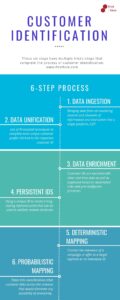Customer Identity: Immediate conversion of sales targets & the revenue multiplier effect
November 28, 2019While attending a recent technology conference, I knew almost everyone except for a few new attendees. My colleague, a new joinee, accompanied me to the event. I thought it was a good idea to bring her along so that we could network more! However, I noticed that each time she interacted with a person, it took longer for her to break the ice than for me, and I was able to get more leads and get new connections through known acquaintances.
To me, this difference was not because she lacked experience. She was very good at her job. But, the real gap was a lack of a connected network. She could neither recognize anyone nor could the attendees associate with her.
I had a stronger identity, which made socializing easier for me than it was for her.
This clearly showed me having a strong identity within my network contributed to my ability to have a more effective event. To me, the value that a ‘customer data platform’ brings to a martech stack is something very similar.
It has a direct impact on the sales conversions and bottom line.
A single customer interacting with your brand across multiple touch points and channels needs to be identified. She may choose to react in a different way each time. Identifying her helps you understand her intents irrespective of the channel.
You could have just started marketing with two known channels or two dozen of them. No matter what the number is, your customer explores and expects different things from each channel. It is interesting to spot how the same customer responds in a different manner on each of the channels that you exist.
Overall, how does it feel when you know that 57% of your customers stop buying from your company because a competitor provided a better experience? This statistic is backed by research. Connecting it back to my experience at the conference, I can conclude that it is all a matter of how well you relate, connect and identify your customer as much as you expect them to know your brand.
How is Customer Identity created?
While there are multiple micro-steps involved in creating a unique customer identity, they can be categorized into 6 steps.

Data Ingestion
Every brand relies on more than two channels to begin with. Each channel provides a variety of opportunities to communicate about your brand. Omnichannel is defined as the use of all channels available for service, distribution, and transaction within a unified experience. This includes online and offline channels. It could spread across these categories of channels — internet marketing, social media channels, physical marketing, paid advertising, public relations, event marketing, telemarketing, and so on.
The initial customer data is collected in the form of email IDs, name, phone number, social profiles, and so on. A unique customer ID is created for each customer. The ID stays as a reference point to add further attributes and secondary data to the ID. This reference point is used in further steps to make it foolproof for a marketer to enhance the customer experience.
Data Unification
Unique customer IDs enable a consistent brand image and unified customer experience across all channels of interaction, information, and transactions. For customer data unification, FirstHive uses AI-assisted techniques to complete each unique customer profile stitched to the respective customer ID.
As different sources provide information about a customer, it is tied to the unique customer ID in different database systems as well as the platform. It provides accurate information when the platform starts using it for real-time activity. It supports processes such as campaign management, cohort segmentation, personalization, and so on.
Data Enrichment
As much as furniture or silverware cannot be left alone in the shelf, it needs to be maintained, customer data also needs to be enriched. Data is organized during the steps of ingestion and unification. It needs to be cleaned to avoid duplication, attributed to the right data sources to help identify patterns, build data format consistencies, and to create consumable customer data.
During this step, IDs are enriched with other real-time data as well as organized based on automated rules and pre-configured processes. Further, related behavioral attributes, transactional updates, and product interactions are updated to that unique ID.
Persistent ID
A persistent ID is assigned to a unique ID. It is a long-lasting reference point that can be used to validate relative attributes. For instance, if you are a bank targeting two people, you may want to confirm if they are related in some way or not to ensure you share information that increases mutual and collective influence. Most often, telemarketers try to sell a product to the husband and wife at the same time or call the spouse of a person who has experienced a demise.
The persistent ID provides intelligent cues to avoid such dissonance in the customer experience. This is possible because FirstHive also ensures identity resolution. Historical data pertaining to a particular ID is not completely eliminated even after deletion.
Deterministic mapping
Using identifiers with deterministic mapping, marketers can connect the relevance of a campaign or offer to a target segment or an individual ID. This helps in gaining insights across cross-device usage, time preferences, product-device usage correlation, and others.
Probabilistic mapping
This is what differentiates our CDP from that of our competitors. With multi-source interaction and multiple accounts of a customer, the goal of a marketer tends to be to identify if the same customer is returning and interacting to achieve different objectives from different touch points. Probabilistic mapping takes into consideration other customer data across the universe that would eliminate any possibility of anonymity.
When sources provide less deterministic value to a customer’s data, statistical methods are applied under probabilistic mapping to identify the closest match. The customer ID includes these aspects, too.
What is Customer Identity used for?
Customer identity is no longer just a marketer’s magic bullet, it also serves the purpose of reputation managers, human resource personnel, anti-fraud managers and other counterparts within an organization. Here are some immediate use cases of customer identity.
Targeted communication
It is more efficient to eliminate guesswork and provide information packaged in the most preferred tone and voice when a marketer knows the customer better. Customer identity enables 1:1 communication building highly relevant context. A leading insurance company scrubbed its customer data using FirstHive. Over time, they did a splendid job of attributing data using the platform. They used this to target customers for upgrades and renewals.
Personalized experience
A leading salon and cosmetics consumer brand used customer IDs to track third-party influencers and of their own customers. Each influencer attracted different customer personas. The brand used customer IDs available on FirstHive to communicate offers for all their associated salons across the nation. They were able to provide coupons and offers that would deliver higher conversions.
Customer loyalty
It is not restricted to a single sector. Use of customer identity is very popular to roll out customer loyalty programs. My favorite one is how a hospitality and realty brand used customer IDs to improve customer retention using customer loyalty programs. Each customer assigned with an ID was tracked to provide highly customized cross-channel communication that led to personalized user experience. This was not just in the pre-acquisition, stage but also while delivering the service. Even before the customer made requests to the concierge, these brands had enough information to provide proactive recommendations to every customer. It included the use of taxi services, spa and gym, clubhouse, and so on.
Some interesting implementations were developed around concepts such as rebates, influence, and privileged access.
Identifying Fraud
Did you notice that when you created a profile for your company with generic email ID on Facebook, in about a day your account gets blocked because there is duplication? Fraud identification is more complex than this when it comes to banks and credit unions. Transaction duplication and fraudulent access to personal information can be prevented with the addition of customer ID.
Accurate customer identification is directly correlated to better customer experience. Forbes has mentioned that consistent brand presentation across all platforms increases revenue by up to 23 percent. However, great customer experiences are always tied to how well the brand knows its customers and how well each customer is able to associate with your brand.
We believe every great customer experience begins with a small step of identifying your customers and then building a relationship. We would be delighted to hear out your efforts to create better customer experiences. Drop a note to marketing@firsthive.com or share your story in the comments section below.


